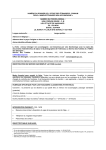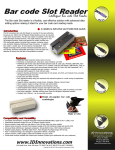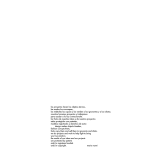Download Pre-Commissioning Tests on Dry Type Transformer
Transcript
National Conference on Recent Trends in Engineering & Technology Pre-Commissioning Tests on Dry Type Transformer Hardik V Rupareliya1, Nidhish G. Mishra2 1 PG Student, Dept of Electrical Engineering, Gujarat Technological University, Gujarat, India 2 Associate Professor, BVM Engg. College, Gujarat, India 1 [email protected] [email protected] 2 Abstract— The purpose of commissioning tests on transformer is to satisfy, to pre-determined standards, that all the equipment erection is correct and that all the equipment connections / cables have been installed in accordance with the approved erection drawings and diagrams. Furthermore to demonstrate to the satisfaction of the client that the foregoing work has been done and that the equipment functions as designed. This paper discussed procedures and testing results of transformer. Index Terms— Commissioning, ACSD, CRT. I. INTRODUCTION whether they are carrying any load or not. 2). Power transformer is used in generating stations and sub stations at each of a power transmission line for stepping up or stepping down the voltage. Above size 500KVA transformer is called Power transformer. This transformer is disconnected during light load period. A Dry type transformer is defined as a transformer in which the core and windings are not immersed in an insulating liquid. A Dry-type transformer having one or more windings encapsulated in solid insulation is called an encapsulated winding dry-type transformer. Transformer is a device that transfers electric energy from one circuit to another, usually with a change in voltage. Transformers work only with a varying electric current, such as alternating current. Transformers are important in the distribution of electric power. They raise the voltage of the electricity generated at a power plant to the high levels needed to transmit the electricity efficiently. Other transformers reduce the voltage at the locations where the electricity is used. Many household devices contain transformers to raise or lower house-current voltage as needed. For example, Television sets and stereo equipment require high voltage where the doorbells and thermostats require low voltages. A simple transformer consists essentially of two coils of insulated wire. In most transformers, the wires are wound around an iron-containing structure called the core. One coil, called the primary, is connected to a source of alternating current that produces an alternating current in the other coil. This coil, called the secondary, is connected to a separate electric circuit. Transformers are classified into mainly two categories. 1). Distribution transformers are used to step down the distribution voltage to a standard service voltage or from transmission voltage to distribution voltage. Up to size 500KVA transformer is called Distribution transformer. We can keep this transformer in operation all the 24 hours a day 13-14 May 2011 Fig. 1. Cast Resin type Transformer Pre-Commissioning Test: Prior to energizing the transformer, several pre-commissioning tests are done. The objective of these tests is to confirm that the transformer has not suffered damage during transit and also to check any inadvertent slips in the factory tests, or supply. II. PRE-COMMISIONING TESTS Following tests are done on the transformer to predetermined standards. A) Turn Ratio Test: Ratio between all the three corresponding H.V. & L.V. phases is to be measured on all B.V.M. Engineering College, V.V.Nagar,Gujarat,India National Conference on Recent Trends in Engineering & Technology taps. It is desirable to do this test by a Ratio-meter. But if it is not available, a simple test of measuring voltages can also serve the purpose. Fig. 2 : Megger Referring to name plate find out which terminals of H.V. & L.V. correspond to one phase e.g. for a vector Group of Dyn11, H.V. Terminals 1U, 1V, & L.V. terminals 2U, 2N correspond to U phase. Apply single phase, 415V or 240V, AC, 50 Hz to H.V. side and measure voltage on the L.V. side. Measure these voltages on all taps and note them in “Commissioning Report”. Repeat for the other two phases. These observations should indicate a consistent trend of variation in line with the details given in name plates. Numerical values should approximately check with the voltage ratio. B) Magnetic Balance Test: This is a simple test to detect shorted turns in a winding. Its principle is that shorted turns oppose establishments of flux in that limb because of the current that circulates through the shorted turns. Apply single phase, 415 or 240V. AC. To such H.V. line terminals which would energies U phase (Outer limb). Use an averaging instrument like a Multimeter. Measure the voltage induced in the V phase (Center limb) and W phase (other outer limb). Measure also the current drawn by the energized phase. This test can, then, be carried out on L.V.Side Centre limb being nearer to the energized limb, more flux passes through it and less flux in the outer limb. The division is around 70-30% & hence the measured voltages will be having approx this proportion. Next, energize W phase and measure the other two voltages as before. Results should be similar to previous ones. Then energize V phase (Centre limb). As both the outer limbs are symmetrically located w.r.t. centre limb, flux will divide equally between them. Hence the voltages measured on outer phases will be equal. Also, for reasons explained earlier, currents drawn when outer phases are excited will be equal, that for centre phase will be less (approx 70%). Thus these observations will confirm the healthiness of the windings. 13-14 May 2011 In case one of the phases has shorted turns, it will draw a comparatively large current when it is energized. When other phases are energized, flux and hence voltage in the shorted phase will be significantly reduced. Hence all three observations will indicate the shorted phase. Note the observations in the “Commissioning Report”. C) Measurement of Insulation Resistance: Measure Insulation Resistance (IR) between windings and between windings and earth with a 2500/1000V Megger, preferably motor driven, otherwise hand- driven. Before measuring I.R. thoroughly clean all the bushings with clean cotton cloth, if required using Carbon Tetrachloride. Also, there should be no external connections to the transformer terminals. Check and adjust, if required, the infinity setting of the Megger. Lead wires from the Megger to the transformer should run independently and be permanently clamped. They should not have any joints. It is known that the I.R. reading continues to increase initially and for comparison purpose, reading is to be taken at 1 minute of energizing. It is also known that I.R. value is dependent on temperature. Hence temperature at the time of measurement should be noted. Compare the I.R. values measured, with the Factory results keeping in view the temperature at the time of measurements. Note the observations in “commissioning Report”. Also measure and note the I.R. values of the Power Cables. D) Measurement of Winding Resistance: To measure the calculation of I2R losses, to Calculate winding temperature at the end of Temperature rise test and as a bench mark for assessing possible damage in the field. If the winding has tapping, then resistance shall be measured at all taps otherwise the resistance of each winding shall be measured by following methods: (i) Voltmeter-Ammeter Method. (ii) Bridge Method. Fig. 3: Measurement of Winding Resistance The resistance is measured at ambient temperature and then converted to resistance at 75 °C. B.V.M. Engineering College, V.V.Nagar,Gujarat,India National Conference on Recent Trends in Engineering & Technology E) Polarity & Vector group Verification: Polarity and phase relation tests are of interest primarily because of their bearing on paralleling two or more transformers. Phase relation tests are made to determined angular displacement and relative phase sequence. Phase relation or vector group verification test is performed on a three phase transformer. The phasor diagram of any three phase transformer that defines the angular displacement and phase sequence can be verified by connecting the HV & LV leads together to excite the unit at a suitably low three phase voltage, taking voltage measurements between the various pairs of leads and then either plotting these values or comparing them for their relative order of magnitude. F) Separate Source Withstand Voltage Test: A normal power frequency, such as 50Hz, shall be used and the duration of shall be one minute. The winding being tested shall have all its parts joined together and connected to the ground and to the other terminal of the testing transformer. The test shall be commenced at a voltage not greater than one-third of the full value and be brought up gradually to full value in not more than 15 s. After being held for the specified time of 60 seconds, it should be reduced to one third or less of the maximum value and the circuit open. This test is successful if no collapse of the voltage occurs. Careful attention should be given for evidence of possible failure that could include an audible sound such as a thump, or a sudden increase in test circuit current. Any such indication should be carefully investigated by observations, by repeating the test, or by other test or determine if a failure has occurred. G) Induced AC over voltage withstand test: In this test, twice of the primary voltage and frequency given on LV side to verify the AC withstand strength of each line terminal and its connected windings to earth and other windings, the withstand strength between phases and along the windings under test. AC Short duration (ACSD) test is intended to verify the AC withstand strength of each line terminal and its connected windings to earth and other windings, the withstands strength between phase and along the windings under test. For Um < 72.5 KV, ASCD test is carried out without partial discharge measurements for 60 secs. For Um > 72.5 KV, the test is normally performed with partial discharge free operation of the transformer under operating condition. However the requirements for partial discharge measurement during the ACSD test may be omitted. ACSD test is always performed with the measurement of partial discharge during the whole application of test. This test is not a design proving test, but a quality control test and is intended to cover temporary over voltages and continuous service stress. It verifies PD free operation of the transformers under operating conditions. Applied AC voltage shall be as nearly as possible sinusoidal and its frequency is sufficiently above the rated frequency to avoid excessive magnetizing current 13-14 May 2011 during test. The test voltage is the peak value of voltage divided by root √2. The test time at full voltage shall be 60 seconds for test frequency up to and including twice the rated frequency. For frequency above twice the rated frequency the time duration of test shall be: 120 X Rated frequency / Test frequency. H) Open circuit test: No-load losses are those losses that are incident to the excitation of the transformer. No-load losses include core losses, dielectric losses and conductor losses in the winding due to excitation current. These losses change with change in excitation voltage. No-load current is the current that flows in any winding used to excite the transformer when all other windings are open-circuited. Fig. 4 Open Circuit Test The purpose of the No-load test is to measure noload losses at a specified excitation voltage and a specified frequency. The no-load loss determination shall be based on a sine wave voltage. The average voltage voltmeter method is the most accurate method for correcting the measured noload losses to a sine wave basis and is recommended. This method employs two parallel-connected voltmeters; one is an average-responding voltmeter; the other is a true rmsresponding voltmeter. The readings of both voltmeters are employed to correct the no-load losses to sine-wave basis. For the determination of the no-load losses of a single phase transformer or a three phase transformer, the frequency of the test source should be within +-0.5 % of the rated frequency of the transformer under test. If the excitation frequency is beyond the specified tolerance, then the test voltage shall be adjusted to maintain the V/F ratio corresponding to the ratio of rated voltage and rated frequency. The voltage is adjusted to the specified value as indicated by voltmeter. Simultaneous values of rms voltage, rms current, power and the average voltmeter reading shall be recorded. (I) Short circuit test: For the H.V. side voltage and the % impedance, it would be possible to calculate the current which would flow in the H.V. side, with 415V applied to it, while keeping L.V. side shorted. If the 415V source can feed that current, a short-circuit test can be carried out. This test would confirm proper contact engagement at all tap positions. Apply 3 Ph. 415V, 50 Hz to H.V. side, keeping L.V. side shorted. Measure the 3 line currents at all tap positions. If the switch is an OFF-CIRCUIT switch, supply B.V.M. Engineering College, V.V.Nagar,Gujarat,India National Conference on Recent Trends in Engineering & Technology has to be disconnected before changing tap. Note the observations in the “Commissioning Report”. (C) Measurement of Insulation Resistance at 28 °C: (i) H.V. winding to Earth: 38.8 GΩ (ii) L.V. winding to Earth: 680 MΩ (iii) H.V. winding to LV winding: 59.4 GΩ (D) Measurement of Winding Resistance: a) HV winding Resistance: (in mΩ) TABLE III MEASUREMENT OF HV WINDING RESISTANCE Tap No. 1 2 3 4 5 Fig. 5 Short Circuit Test A Consistent trend indicates healthiness. If short circuit test is not possible due to limitation of source carry out one tap changing operation over the entire range increasing as well as decreasing. III. CASE STUDY This is the study of tests conducted on 11th Oct 2010 of 500 KVA Cast Resin Transformer (CRT) at VOLTAMP TRANSFOMERS LTD. Under guidance of Mr. Rajendra Chaudhri and Mr. Pankit patel. The specifications of the CRT are as follows: Job No. : 18530/1 KVA : 500 Voltage ratio: 3300 / 433 Vector Group: Dyn1 Type of tap changer: Off load tap changer The Calculations of various tests performed on this CRT are as follows: \ (A) Turn Ratio Test: TABLE I RATIO OF HV / LV PHASE MEASUREMENT Tap No. 1. 2. 3. 4. 5. U/u 13.859 13.526 13.193 12.859 12.526 V/v 13.859 13.525 13.191 12.859 12.525 W/w 13.860 13.526 13.193 12.858 12.526 (B) Magnetic Balance Test: TABLE II MEASUREMENT IN VOLTAGE 2U2n 25.7 V 12.5 V 7.99 V 2V2n 17.82 V 25.6 V 17.14 V 13-14 May 2011 2W2n 8.11 V 12.08 V 25.34 V 1U1V 226.8 221.6 215.9 209.9 204.1 1V1W 226.8 221.17 215.1 209.9 204.1 1W1U 227.0 221.7 215.5 209.9 204.1 b) LV winding Resistance: (in mΩ) TABLE IV MEASUREMENT OF LV WINDING RESISTANCE 1.404 1.406 1.408 2U2n 2V2n 2W2N (E) Polarity & Vector group Verification: TABLE V POLARITY & VECTOR GROUP CHECK 1U1V 425 V 1V1W 1W1U 423 V 422 V 1V2v 375 V 1V2w 423 V 1W2w 374 V 1W2v 374 V Vector Group Checked (Dyn1): O.K. (F) Separate Source Withstand Voltage Test: a) Applied 10KV between HV winding to Earth for 1 min. b) Applied 3 KV between L.V. winding & Earth for 1 min. (G) Induced AC over voltage withstand test: Applied 2 x 433 Volts at 124.8 Hz for 50 Secs. (H) Open circuit test: PT ratio P: 660/110 =6 CT ratio C: 20/1 =20 WMSM = 0.2 Total MF= C*P*WMSM = 24 B.V.M. Engineering College, V.V.Nagar,Gujarat,India National Conference on Recent Trends in Engineering & Technology TABLE VI O.C. TEST MEASUREMENT %Voltage Vavg Vrms Ir Iy Ib W1 W2 W3 90% 65 65 0.21 0.17 0.22 20 12.5 9 100% 72.5 72.33 0.35 0.28 0.37 28 17 7 110% 79.5 79.33 0.71 0.55 0.76 48 26 (- 4) No Load Loss in Watts (90%) =(W1+W2+W3)* Total M.F.= (41.5)*24=996 No Load Loss in Watts (100%) = (52)*24=1248 No Load Loss in Watts (110%) = (70)*24=1680 (I) Short circuit test: PT ratio P : 440/110=4 CT ratio C: 120/1=120 WMSM = 0.2 Total MF= C*P*WMSM =96 Temp. = 28 °C 13-14 May 2011 Load Loss in Watts (Tap 5) = (55)*96=5280 IV. CONCLUSIONS Dry type Resin cast Transformers requires very little maintenance from time to time. However, inspection should be made at regular intervals & corrective measures shall be taken when necessary to ensure the most satisfactory service from this equipment. Evidence of rusting, corrosion on enclosure and deterioration of the insulation and paint should be checked and corrective measures shall be taken whenever necessary. (1) (2) TABLE VII 1 0.69 0.695 0.695 45 46 45 16 17 17 Load Loss in Watts (Tap 3) = (53)*96=5088 REFERENCES S.C. TEST MEASUREMENT Tap No. Ir Iy Ib Vry Vyb Vbr W1 W2 W3 Load Loss in Watts (Tap 1) =(W1+W2+W3)* Total M.F. = (50)*96=4800 3 0.73 0.73 0.73 44 44 43 17 17.5 18.5 5 0.77 077 0.78 41 42 41 18 18.5 18.5 (3) (4) (5) (6) (7) “Service Manual for installation, commissioning, operation and maintenance of transformers” VOLTAMP TRANSFORMER LTD. “Testing of Three Phase Power transformer” by Brahambhatt Sohil H, SVIT-VASAD. Operation, Installation, Commissioning & Maintenance Manual”, by TRANSDELTA TRANSFORMERS PVT LTD. “Electrical Testing & Validation”- O’HARA ENGINEERING SERVICES LTD. “PRESENTATION ON CAST RESIN DRY TYPE TRANSFORMERS” by VIJAI ELECTRICALS LTD. www.eaton.com Web Source on Dry-type Transformer. B.V.M. Engineering College, V.V.Nagar,Gujarat,India














